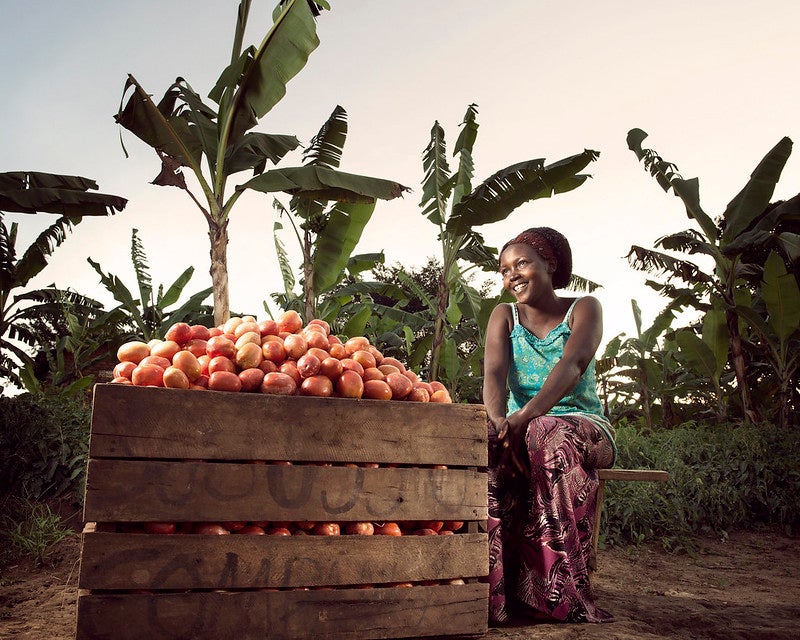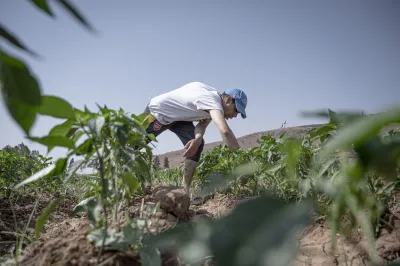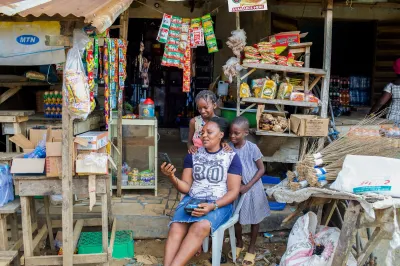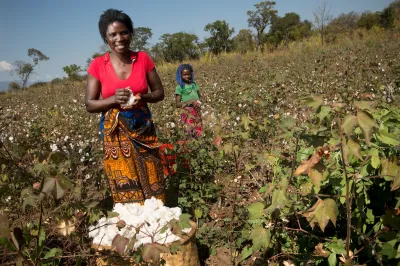How Can We Build on COVID-19 Progress in Women’s Financial Inclusion
This post is also available in French on the FinDev Gateway.
Women’s rights activist Malala Yousafzai once famously said, “We cannot succeed if half of us are held back.” Nearly two years into the COVID-19 pandemic and the immense social and economic strain it has placed on women and girls, Malala’s statement is as relevant as ever: gender inequalities threaten our economic recovery and resilience.
Yet when it comes to financial inclusion, COVID-19 has also presented opportunities to push for greater equality. The pandemic has heightened awareness of financial exclusion’s impact on gender equality, spurred investment in digital infrastructure and tools, and led to an unprecedented surge in digital payments and new accounts, including among millions of women. In doing so, it has laid before us new and unique opportunities to get women’s financial inclusion right.
However, achieving this will require the focused, intentional efforts of all development partners and government officials, together with strong multi-sectoral partnerships.
The multiplier effect of women’s financial inclusion

Women constitute two-thirds of the world’s remaining unbanked population. Despite significant progress in financial inclusion overall, the gender gap in account ownership has remained constant over the last decade at 9 percentage points in developing countries, according to Findex.
Yet women’s financial inclusion has a multiplier effect that benefits women, their households and their communities. To begin with, financial services help women to generate income. For example, researchers have shown that proximity to mobile agents has enabled poor women in Kenya to save more money, weather financial storms and escape poverty; it has encouraged some women to move from farming to entrepreneurship.
Financial services also help women to increase household access to essential services. In Nepal, for instance, women who opened no-fee savings accounts increased household spending on education and nutritious foods, and kept their daughters in school.
Finally, households become more resilient when women use financial services. A study in Ghana found that financial inclusion significantly improves household financial resilience and that financially included women contribute to their household well-being as much as men, with greater impacts for women in rural areas, particularly for those who receive mobile money remittances.
Key research demonstrating the multiplier effect of women’s financial inclusion has been synthesized by the Bill and Melinda Gates Foundation. Ultimately, women’s financial inclusion is important for unlocking and fairly distributing the full economic and social potential of economies.
The triple opportunity to advance women's financial inclusion
.
First, COVID-19 has spurred unprecedented progress in opening accounts to support government-to-person (G2P) payments. Globally, 477 million new social protection digital accounts were opened over the last two years, including 262 million accounts for women. Roughly 80 million women opened their first account to receive G2P payments during the pandemic. In Brazil alone, 14 million women used a digital savings account for the first time to receive such payments. These newly created accounts represent a promising gateway to financial services that can support savings and productive investments for women.
Globally, 477 million new social protection digital accounts were opened over the last two years, including 262 million accounts for women.
Second, the pandemic has sped up investments in digital infrastructure and tools, which are helping to create more vibrant and robust digital economies. The array of use cases for digital payments, e-commerce platforms, and the digital sharing of information and data exploded during the pandemic. As governments seek to ensure their digital transformations are sustainable and poised for economic growth, they create an opportunity to bring more women into the formal digital economy and close gaps in access and usage of digital services.
Third, COVID-19 has shined a spotlight on the inequalities and burdens of women and girls. Women have suffered disproportionately during the pandemic, both socially and economically. When governments swiftly developed their stimulus plans, they realized that women were more likely to lack IDs and work in the informal sector, excluding them from government support. Global fora like the Generation Equality Forum, along with clear commitments from countries, regional bodies like the African Union, multilateral organizations like the World Bank and IMF, and FinEquity — the global community of practice on women’s financial inclusion convened by CGAP — have helped to increase awareness of these trends. Together, they have generated momentum for bringing all hands on deck to mitigate risks to women and ensure women fully participate in the COVID-19 recovery and the digital economy of the future.
There is an opportunity to leverage this unique moment in history to expand women’s access to a range of financial services that meet their needs beyond G2P transfers, including savings, loans, insurance, remittances and more. For women to thrive, they need access to financial services that enable them to take advantage of economic opportunities, access essential services for themselves and their families, and build resilience to shocks.
What can we do to take advantage of this opportunity?
Promoting further digital development does not guarantee women’s financial inclusion. To the contrary, further digitization is likely to widen the digital divide if we are not careful. Today, women in low- and middle-income countries are 7% less likely than men to own a mobile phone and 15% less likely to access the internet through a phone, according to GSMA. Unless we target women specifically when designing and implementing digital solutions, the disparity will deepen.
Therefore, taking advantage of the opportunity in front of us will require purposeful strategies aimed at addressing barriers to women’s financial inclusion and at enabling women’s participation in the growing digital economy. Tackling the following six specific challenges faced by women when accessing digital financial services are the essential first foundational steps:
- Build equitable foundations. We need to address gender gaps in the prerequisites for financial and economic inclusion: phone ownership, internet connectivity, digital IDs and legal requirements.
- Innovate to bring costs down. Income and livelihoods gaps, mobility gaps and other issues make the typical cost of financial services prohibitive for women. We need to get creative about channels and tools that reduce costs and promote a robust competitive digital economy, including open-access systems, to open up choices, increase competition and bring down costs.
- Enhance women’s digital and financial capabilities. Women often have lower basic literacy and numeracy, digital and financial literacy, and awareness of how to open accounts. This limits women’s ability to confidently use financial services and can be addressed with adequate educational programs.
- Develop services relevant to women’s daily life. It is important for financial services to be relevant to women’s daily life and needs. This can be done, for instance, by linking financial services to essential services that women need, such as education, health and transportation.
- Design services and distribution for women’s needs. Because women have more mobility constraints than men, services need to be offered in convenient locations. Hiring women for leadership and client-facing roles at financial intermediaries could also help ensure product design and distribution reflect women’s needs.
- Improve safety through adequate consumer protection. Nothing erodes confidence and trust in financial services like online harassment, fraud and privacy violations. According to new research by Daryl Collins, there are gender differences in how women both perceive and experience online data privacy and protection violations. Strong grievance mechanisms and recourse, especially when capability and systems strength are not reliable, is absolutely critical.
To be sure, addressing these obstacles requires taking into account, and possibly shifting, gender norms. Common gender norms that impede women's financial inclusion include beliefs that men are the most important financial customers, that women should have limited (or no) financial independence, that women should use their money for communal or family benefit, and that women should bear a disproportionate share of unpaid care work. Without addressing these norms, efforts to eliminate barriers to women's financial inclusion will be limited.
Ultimately, we can help more women to participate in the digital economy. This isn’t only life-changing for poor women. It can also benefit economies.
Changing entrenched gender norms requires interventions beyond the financial sector and cross-sectoral approaches. Yet digital financial services themselves could play a catalytic role in changing existing dynamics and addressing gender norms. In India, for example, digitized wage payments to women temporarily employed by public works programs, combined with account usage training, generated a large increase in economic activity, mobility and decision-making power for previously socially constrained women.
Successful strategies to reach women with more tailored financial services have involved integrating a gender lens from the start and identifying product designs and delivery mechanisms that can address underlying norms and other barriers to women's financial inclusion. Efforts should be aimed at empowering women as financial service customers. For example, G2P programs can be more impactful when they are designed with women in mind and give them more choice over where and how to receive funds.
By addressing these challenges and expanding the foundations of women’s financial inclusion, we can better empower women to manage their daily lives, achieve their aspirations, enhance their household wellbeing and resilience, and gain more agency and control. Ultimately, we can help more women to participate in the digital economy. This isn’t only life-changing for poor women. It can also benefit economies. For example, if the gap in sales between female and male vendors was closed, over US$280 billion could be added to the value of the Southeast Asian e-commerce market between 2025 and 2030.
A call for action
But for this to materialize, it is essential to incorporate a gender-smart lens to the design and implementation of financial inclusion, economic recovery and digital transformation programs at the local, regional and global levels. Unlocking the full potential of women’s financial inclusion will require addressing gender norms through collaboration among a multitude of stakeholders across sectors, not just within the financial inclusion community.
Today, CGAP, the Bill & Melinda Gates Foundation, and GIZ offer three commitments to accelerating progress toward women’s financial inclusion:
- Building a strong evidence base for solutions, with robust gender-disaggregated data. We have built strong research on key barriers to women's financial inclusion, and there are case studies and experiments that provide insights into what works. However, massive measurement and evidence gaps remain on what works, for whom, under what circumstances, and what behavior change is required to scale solutions. Thus, we hope to contribute to consolidating lessons learned, identifying knowledge gaps and exploring solutions. We will mainstream gender equality into all aspects of our work to continue building a strong solution-oriented evidence base on women's financial inclusion.
- Amplifying the role of women’s financial inclusion for broader empowerment and impact. We believe financial inclusion is a means to enhance women’s ability to generate income, access essential services and build resilience to shocks. We believe this, in turn, contributes to greater economic growth and resilience. Thus, we will continue to advance global knowledge on the benefits of women's financial inclusion.
- Spurring partnerships for innovation, action and policy change on the ground. Advancing women’s financial inclusion will require new partnerships, beyond traditional financial-sector actors, especially to address constraining gender norms. We hope to develop a consensus on what role different actors can play to contribute to greater women's financial inclusion.
We would like to invite all stakeholders to join us in a concerted effort to achieve greater women's financial inclusion.
Sophie Sirtaine is CEO of CGAP. Jamie Zimmerman is Gender Lead, Financial Services for the Poor, at the Bill & Melinda Gates Foundation. Klaus Prochaska is Head of Financial Systems Development at GIZ.




Add new comment